Raw Milk Mozzarella
Lindsay Harris of Family Cow Farmstand in Hinesburg has been teaching popular raw milk mozzarella classes for City Market this summer. In addition to being a resource for people who want to know more about raw milk, she makes homemade mozzarella look easy.

Lindsay points to a picture of a favorite family cow in her brochure.
Family Cow Farmstand is the first certified raw milk dairy in Vermont. That means they adhere to rigorous safety and milk testing standards.
Under Vermont state law, certified dairies are allowed to sell up to 40 gallons per day of raw milk on their premises or for home delivery – up from just 25 quarts for Vermont dairies a few years ago.
While raw milk dairy classes are legal, thanks to the efforts of consumer advocacy of organizations like Rural Vermont, the products made in them cannot legally be sold. So in the meantime, Lindsay says “I teach people how to make their own delicious farm-fresh cheeses.”
But first, Lindsay answered queries from the class about the safety of raw milk. Raw milk that is tested for pathogens and intended for consumption is more hygienic, she maintains, than pasteurized milk. Pasteurized milk can afford to be less sanitary because the pasteurization (heat) will kill all the bacteria, good and bad, in the milk. In addition, pasteurized milk does not contain the vitamins and enzymes present in raw milk.
As for making mozzarella, the mozzarella was done in under an hour from start to sampling. While I didn't get a picture of the beautiful ball of mozzarella – it was large enough to be held in 2 hands – I did snap a picture of the sample we each ate the end:

Fresh mozzarella with heirloom tomato and basil
Look for more mozzarella classes with Lindsay Harris and City Market.
Homemade Mozzarella
1 gallon milk (NOT ultra-pasteurized)
1 tsp. citric acid crystals [BULK]
1 cup cool water
¼ tsp. liquid rennet (OR according to package directions) [VEG. RENNET IN DAIRY COOLER]
2-3 Tbs. salt
SUPPLIES:
Large pot
Thermometer [AISLE 4]
Rubber gloves [AISLE 3]
Bowl with ice water
Pour cold milk into large pot.
Dissolve citric acid crystals in ½ cup cool water. Stir this solution gently and thoroughly into cold milk.
Slowly heat the milk to 90F while stirring frequently.
Meanwhile, dissolve rennet in ½ cup cool water.
Take the milk off the heat and very gently but thoroughly stir in rennet.
Let milk sit undisturbed for 10 minutes or until you get a mass of curds that breaks cleanly. You may have to put a little heat under it if the curds are not setting up well.
Meanwhile, mix salt into bowl of ice water to make the brine.
Use a long knife to cut the curds into 1x1 inch columns.
Heat the contents of the pot to 130-140F. Very gently stir the curds as you heat up the pot. The curds will become gooey and stretchy and stick together when the whey reaches 130 or 140F. Using rubber gloves, pull the mass of curds out of the whey. Stretch and work them for 10 seconds or so – not too much, or they’ll get rubbery. Whey will pour off as you work them. Submerge cheese in icy brine to cool for an hour or so. Enjoy cheese immediately and/or store moist (but not submerged) in the fridge in an air-tight container.
Notes:
For those interested in making mozzarella, you can use store-bought milk that is not ultra-pasteurized.
While it’s unlikely that you will want to save it for long (!), Lindsay recently discovered you can make an extra salty brine (perhaps 1 Tbs. salt to 1 cup water), and keep it fresh longer in the fridge.
Check out New England Cheesemaking Supply for more cheese-making supplies.